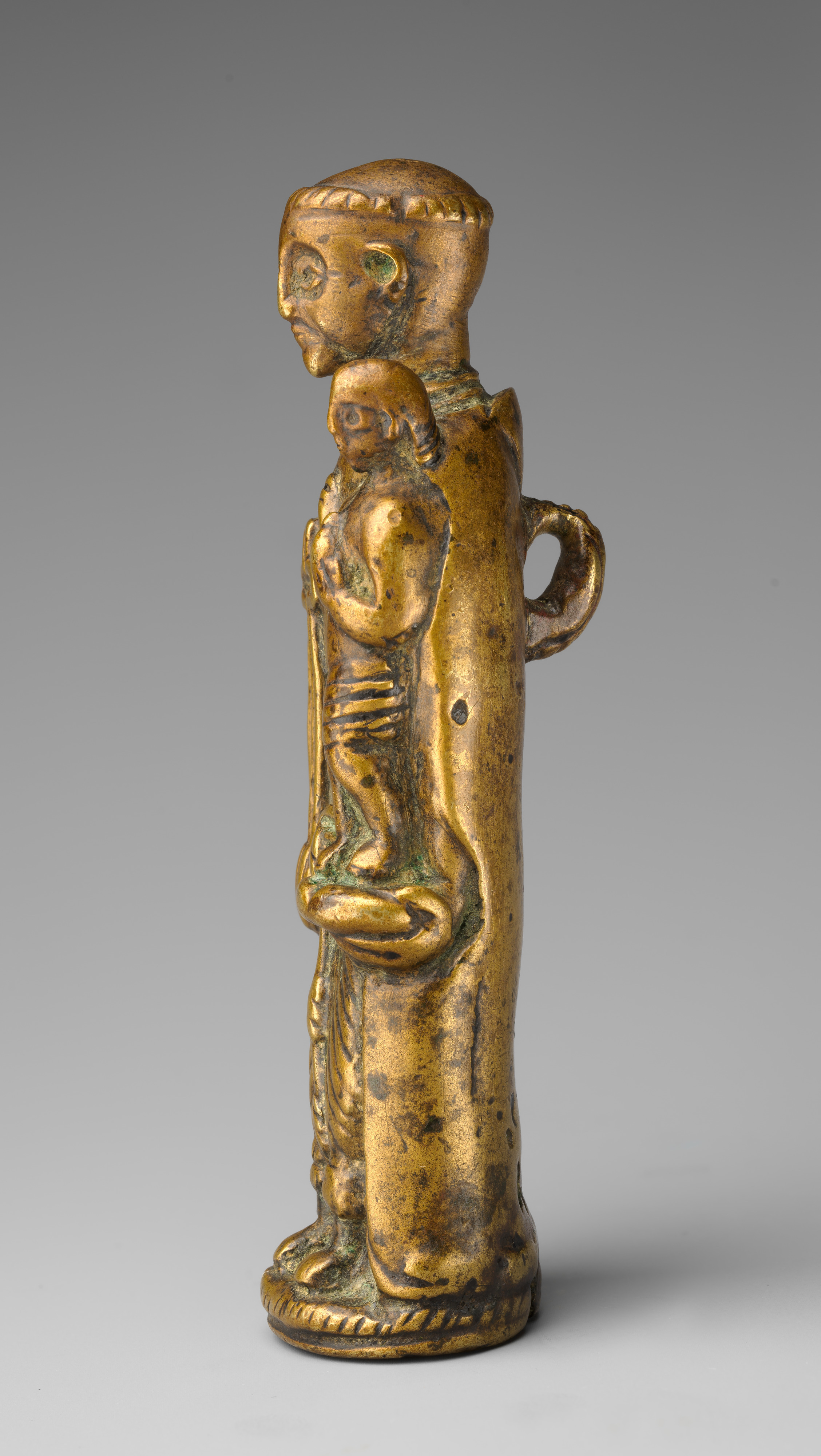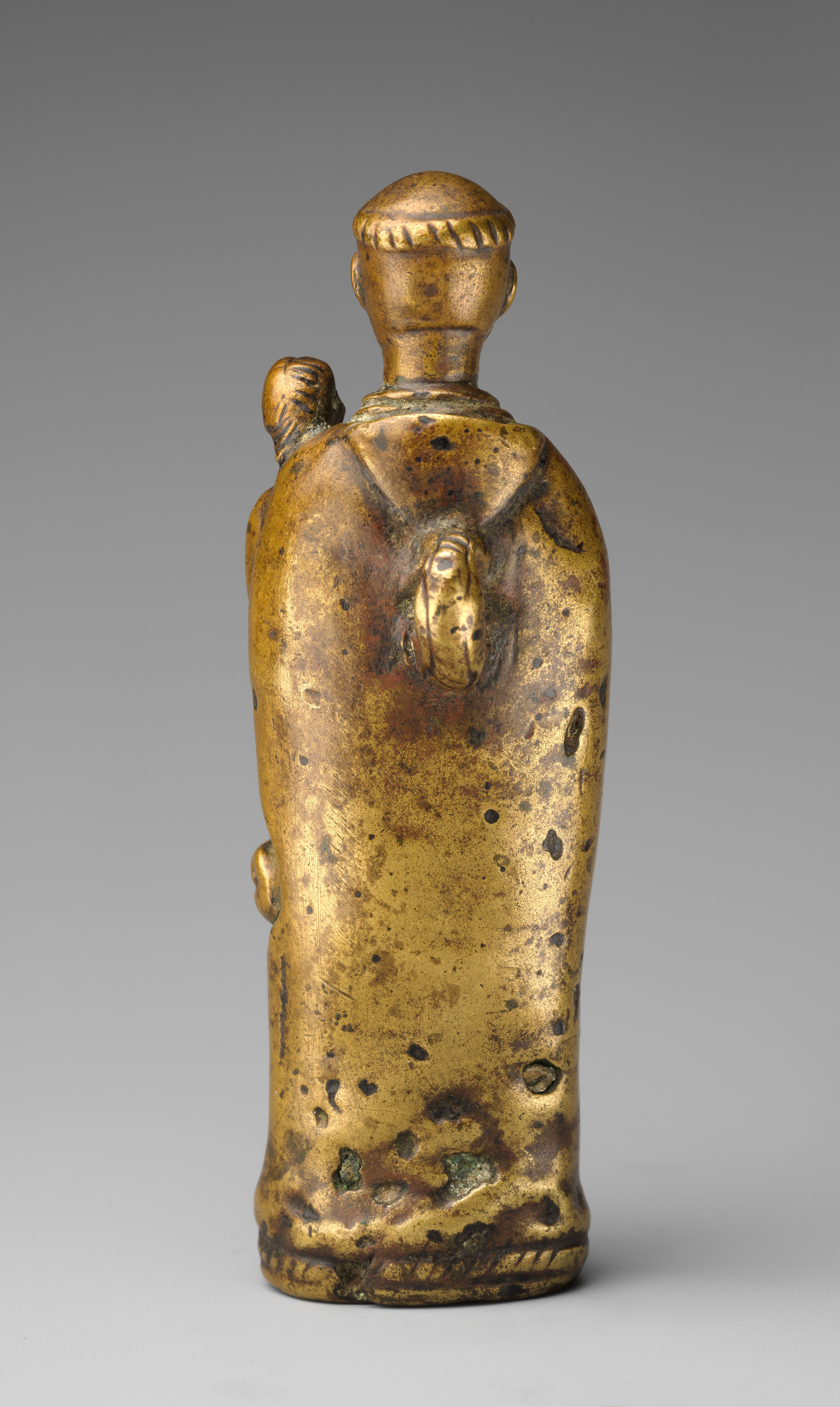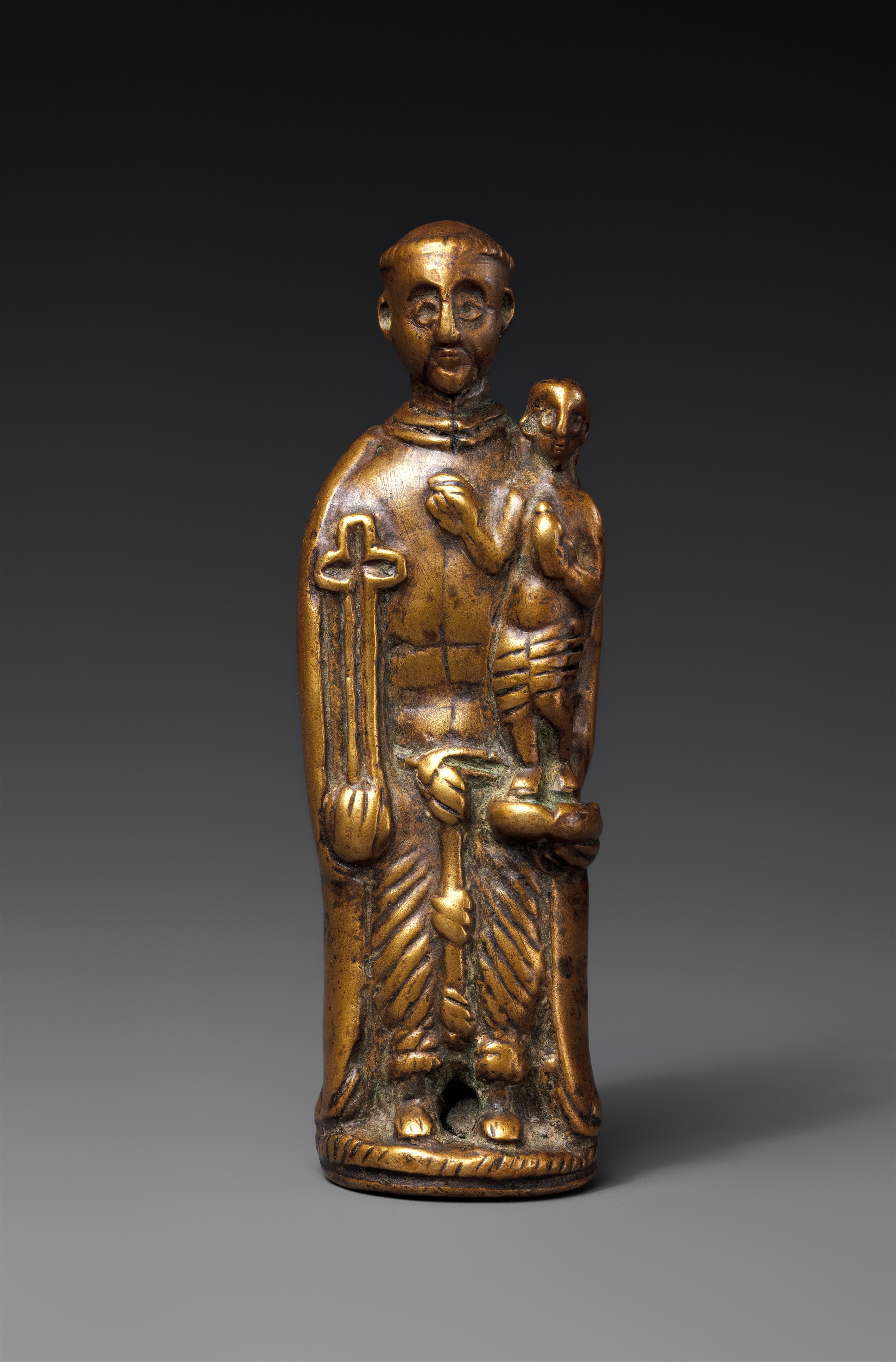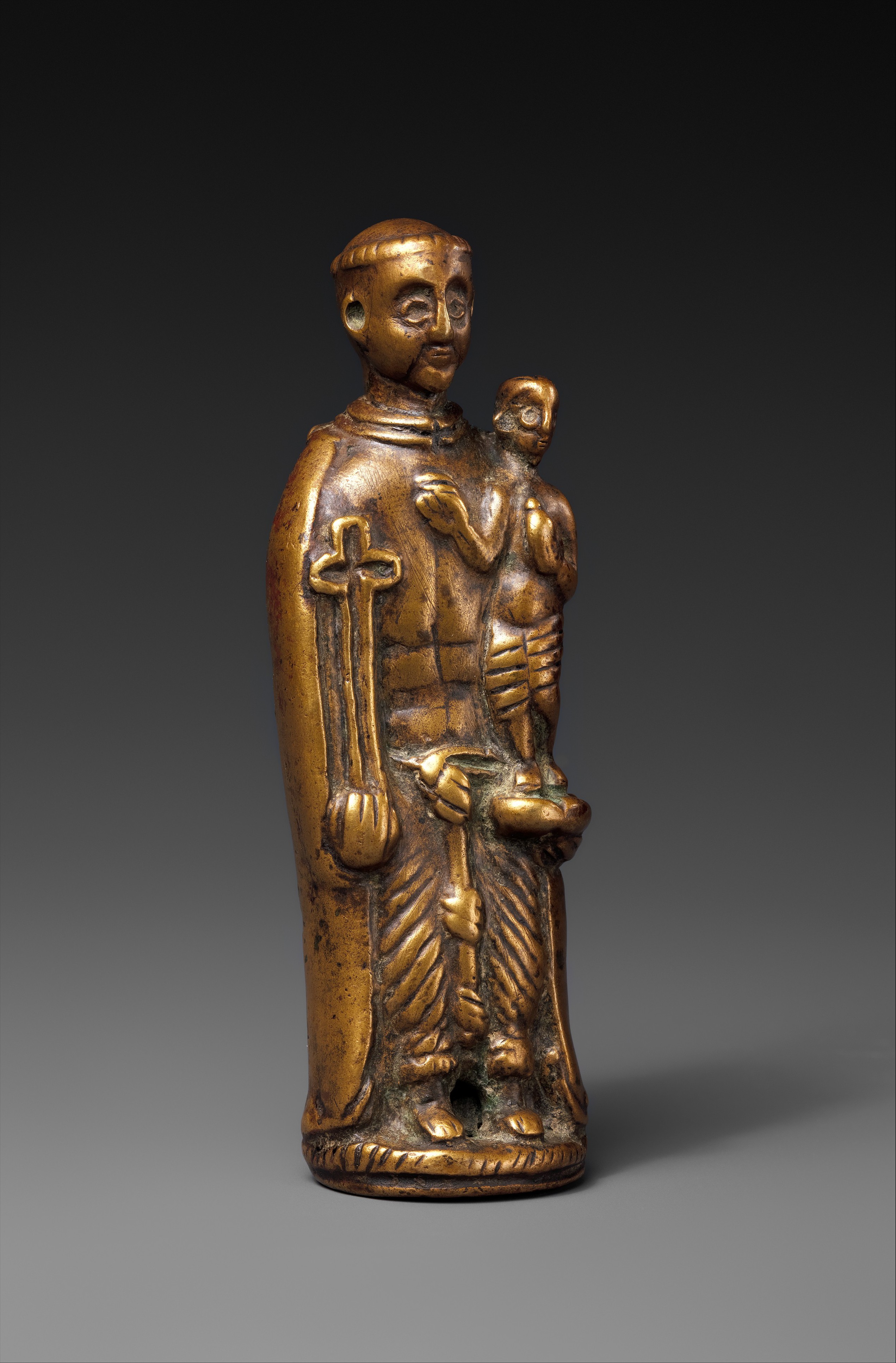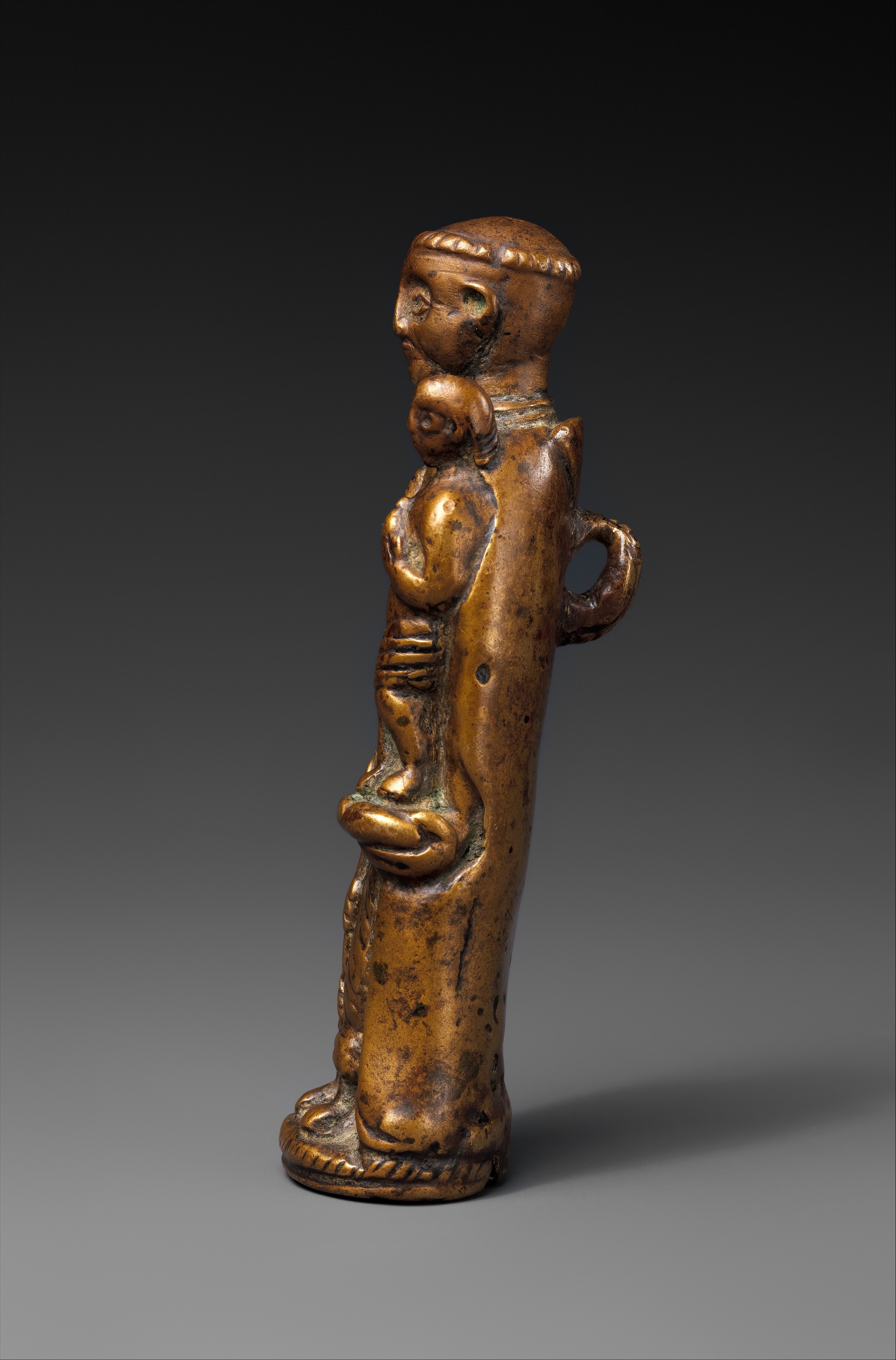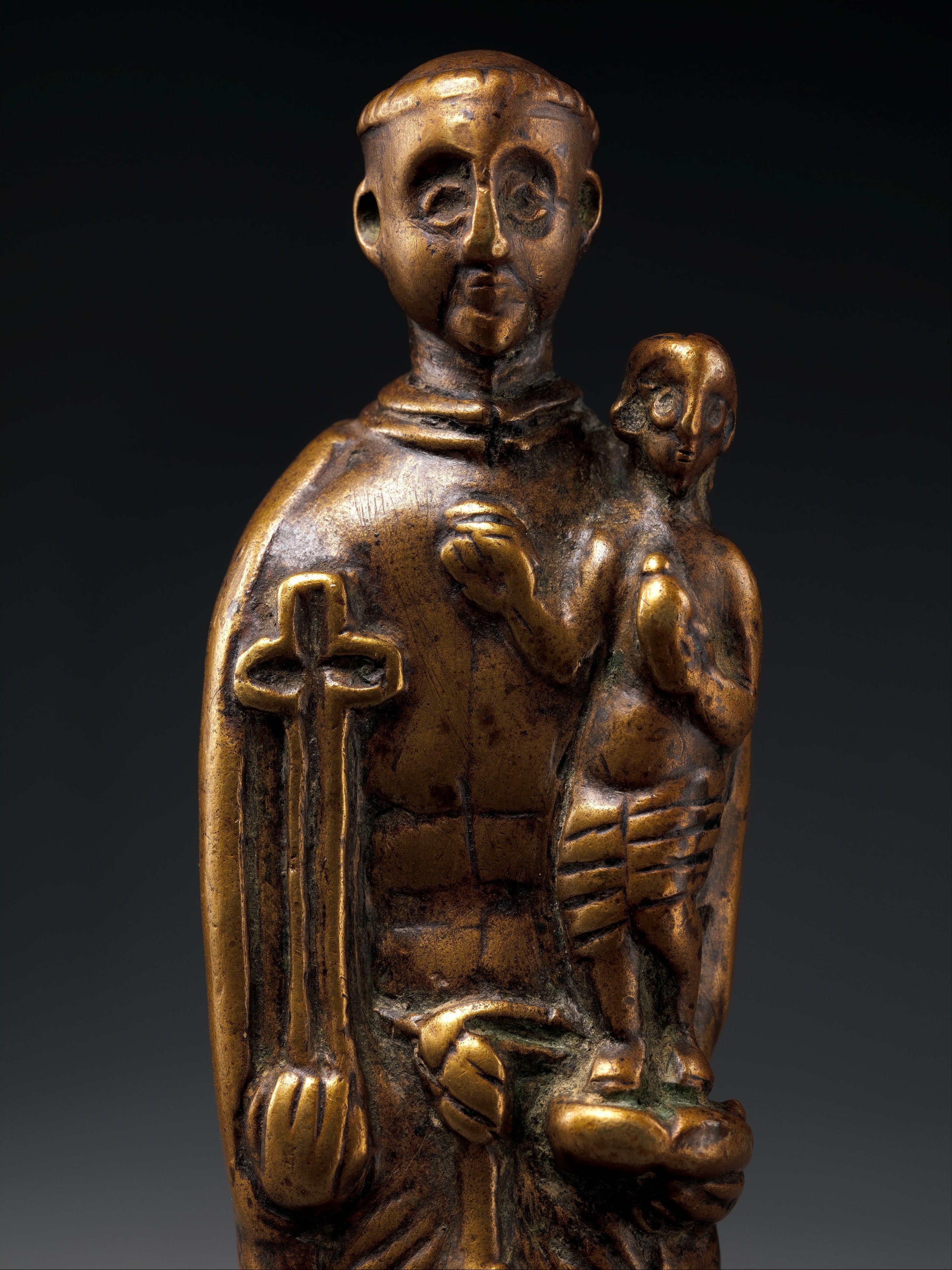Pendant: Saint Anthony of Padua
Not on view
This brass pendant of St. Anthony of Padua holding the infant Christ is an exceptional example of the casting prowess of Kongo artists. The diminutive size of this brass object and the loop posited at the tip of its inverted triangular hood indicate that it is a pendant. Originally cast with crisp detail, portions of the figure are now shiny and worn, suggesting that the pendant came into contact with the skin through active wear, or that it was repeatedly handled. Altogether, the saint’s impression is one of calm alertness, like that of the wide-eyed Christ child, who looks forward as he stretches out his arm across the chest of the elder saint, gesturing towards the outlined crucifix in the saint’s right hand. Though only an infant, Christ is half the size of the saint, emphasizing his importance in Christian theology. His physical proximity to the cross alludes to his future sacrifice, as does the goldfinch he holds, a symbol of both his crucifixion and resurrection. He stands upon an open book, an allusion to a story in which Christ is said to have appeared out of the book that St. Anthony was meditating over. Each figure has bare feet, and wears a robe whose folds have been indicated by carefully incised parallel lines. The toes and fingers are articulated with simple lines. St. Anthony stands feet shoulder width apart, toes pointed out, on a circular base with vertical hatching. His habit has been carefully observed and replicated, from the double-band at the neck to the sweeping cape that falls to his feet, framing the garment beneath. The detail of his triple-knotted belt shows not only the sculptor’s powers of observation, but also hold symbolic power as representations of the three vows of the Franciscan order (poverty, chastity, and obedience). The saint’s eyes are formed by circular outlines framed by high arching eyebrows that flow directly into the triangular nose. Above his short forehead, his head is bald except for a ring of hair. Known as a tonsure, this shaved hairstyle represented an act of religious humility.
A dark black resin and green patination have also accumulated in the crevices of the carving, and around the figures’ feet. The interior of the hanging loop is worn from use, indicating that something was threaded through the loop to suspend the pendant form. Examinations performed in 2001, 2002, and 2013 by Conservator Ellen Howe, Conservator Leslie Gat, Conservation Scientist Mark Wypyski, Conservation Scientist Adriana Rizzo, and Conservation Fellow Ainslie Harrison, suggest that the brass pendant was cast using the lost wax casting technique. The pendant is similar to another example in the Met’s collection, incorporated into a Kongo crucifix, an unusual depiction of the saint.
Catholic since the late fifteenth century, the Kongo Kingdom fostered devotion to many saints. St. Anthony was among the most popular, and was called Toni Malau ("Anthony of Good Fortune") for his purported powers of healing and good luck. The figure’s attributes confirm his identity: the cross held in his proper right hand, the Christ child balanced on the low curve of his left elbow, and his simple habit. The additional iconography of the goldfinch and book are indicative of early models of the saint; these attributes generally grew smaller, or completely disappeared in later models. The popularity of Saint Anthony in Kongo was part of an early modern phenomenon in which the saint was equally popular in Europe, South America, and Africa. Born in Lisbon, Portugal in 1195, the Franciscan brother Anthony was canonized just one year after his 1231 death in Padua, Italy. Claimed as a patron saint by both Portugal and Italy, religious missionaries from both regions spread his cult globally. Soon after their 1645 arrival in Kongo, Italian Capuchin fathers began to spread the cult of St. Anthony. While most early images of the saint were brought from Europe, some came to Africa via other sources. Most missionaries traveled indirectly to Africa via Brazil, where they sometimes purchased religious sculptures from Portuguese colonial workshops. In the Kongo kingdom, locally made figures of Saint Anthony based on European prototypes became common around the eighteenth century. The practice most likely related to the saint’s popularity in the kingdom, and was possibly tied to the short-lived Antonian movement, during which the Kongo noble woman Beatriz Kimpa Vita gained a significant political following after declaring herself the reincarnation of St. Anthony. To the chagrin of European missionaries, the Antoniens adopted the metal, ivory, and wooden images of St. Anthony, wearing the sculpture of the saint they called Toni Malau as a sign of their allegiance and as a protective amulet. Known as "Little Anthonies," her followers occupied the capital and traveled throughout the Kongo kingdom wearing their medallions, spreading the message of Dona Beatriz, who believed that Africanizing the church would strengthen the Kongo state, which was in disarray after a series of civil conflicts and the rising effects of the Transatlantic slave trade.
While the Antonien movement was successfully put down in 1706, St. Anthony remained popular long after. Considered the "Saint of Good Fortune" or the "Saint of Prosperity," Toni Malau figures continued to be used prominently in Kongo as forms of protection from illness, the troubles of childbirth, or other problems.
Kristen Windmuller-Luna, 2016
Sylvan C. Coleman and Pam Coleman Memorial Fund Fellow in the Department of the Arts of Africa, Oceania, and the Americas
Exhibition History
"Kongo: Power and Majesty," The Metropolitan Museum of Art, New York, NY: September 18, 2015–January 3, 2016
"African, Oceanic, and Ancient American Art: Recent Acquisitions" Michael C. Rockefeller Special Exhibition Gallery, The Metropolitan Museum of Art, New York, NY: May 22–Oct. 28, 2001
Published References
LaGamma, Alisa. Kongo: Power and Majesty. New York: The Metropolitan Museum of Art, 2015, p. 108, fig. 65.
LaGamma, Alisa. "The Metropolitan Museum of Art, New York." African Arts 34, no. 2 (2001): 72–77.
LaGamma, Alisa. "Recent acquisitions: a selection, 2000-2001." Metropolitan Museum of Art Bulletin 59, no. 2 (2001): 72–77. p. 74.
de Bouveignes, Olivier. "St. Antoine et la pièce de vingt reis." Les Amis de l'art indigène du Congo belge (1947): 17–22. (illustrated p. 19)
Further Reading
Fromont, Cécile. The Art of Conversion: Christian Visual Culture in the Kingdom of Kongo. Chapel Hill, NC: University of North Carolina Press, 2014.
Pereira, Mario, and Kristen Windmuller-Luna. "Kongo Christian Art: Cross-Cultural Interaction in the Atlantic World." Kongo: Power and Majesty Exhibition Blog, The Metropolitan Museum of Art (blog), October 30, 2015. http://www.metmuseum.org/exhibitions/listings/2015/kongo/blog/posts/kongo-christian-art.
Thornton, John K. The Kongolese Saint Anthony: Dona Beatriz Kimpa Vita and the Antonian Movement, 1684–1706. Cambridge, U.K.: Cambridge University Press, 1998.
Due to rights restrictions, this image cannot be enlarged, viewed at full screen, or downloaded.
This artwork is meant to be viewed from right to left. Scroll left to view more.


